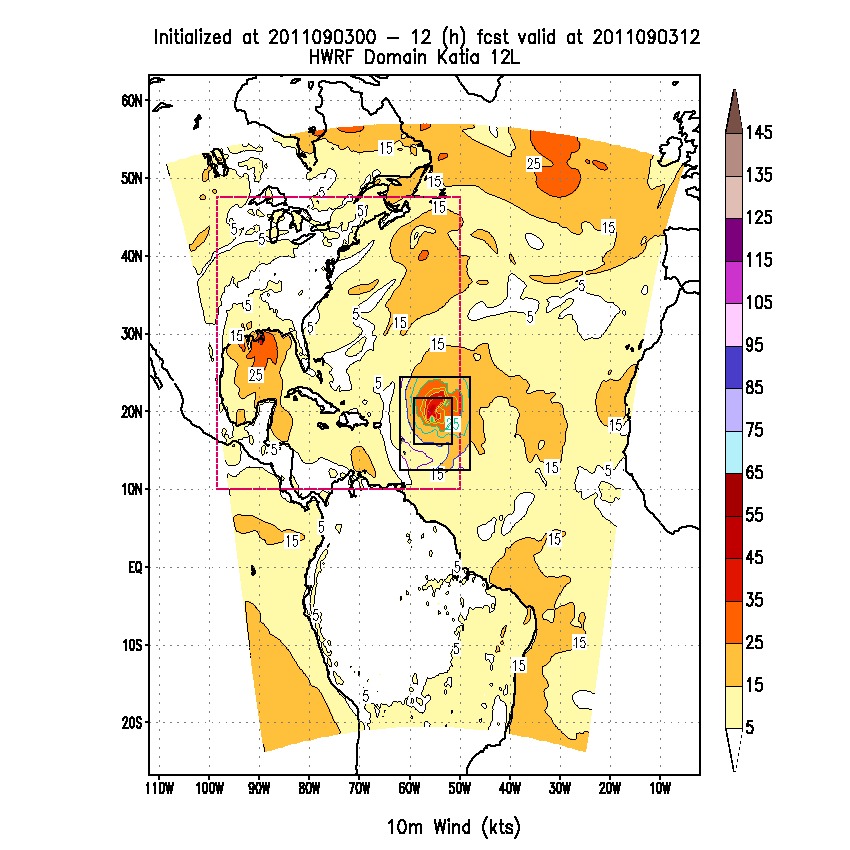HWRF PS:85.98.98.88.88.2.84 (HD12)

HWRF PS:85.98.98.88.88.2.84 (HD12) Configuration Description
- Code
- Model
- Domain
- Cases
- Verification
Codes Employed
The software packages used in the HWRF HD12 RC runs were obtained from the HWRF code repository hosted by the Developmental Testbed Center. The versions of all codes have received minor updates since the HWRF v3.4a release in August 2012 but are still very comparable to the HWRF 2012 operational implementation. The revision numbers included:
•WRF - branches/HWRF revision 5957
•WPS - branches/HWRF revision 704
•UPP - branches/HWRF revision 280
•GSI - branches/HWRF revision 947
•HWRF-utilities (atmospheric initialization, miscellaneous libraries and
tools) - branches/HWRF revision 245
•Princeton Ocean Model for Tropical Cyclones (POM-TC) and POM-TC
initialization - branches/HWRF revision 186 was used for the HD12
configuration.
•NCEP Coupler - branches/HWRF revision 69
•GFDL Vortex Tracker - revision 143
•National Hurricane Center Verification System and scripts for
aggregation of verification statistics and computation of
confidence intervals - revision 37
HWRF PS:85.98.98.88.88.2.4 (HD12) Reference Configuration
| Microphysics: | Tropical Ferrier |
| Radiation (LW/SW): | GFDL/GFDL |
| Surface Layer: | GFDL |
| Land Surface: | GFDL slab model |
| PBL: | GFS |
| Convection: | Simplified Arakawa-Schubert |
Other run-time settings
• Domain 1 timestep = 45 s; Domain 2 timestep = 15 s; Domain 3
timestep = 5s
• Calls to the turbulence, cumulus parameterization and
microphysics were made every 3 minutes on Domain 1, 2 and 3
• Calls to radiation were made every 60 minutes on Domain 1, 2 and
3
• Coupling to the ocean model and nest motion are restricted to
a 9-minute interval
Domain Configuration
The HWRF domain was configured in a similar way as the 2012 NCEP/EMC operational system. The atmospheric model employed a parent and two movable nested grid. The parent grid covered a 80x80 deg area with approximately 27 km horizontal grid spacing. There were a total of 216 x 432 grid points in the parent grid. The d02 domain covered a 11 x 10 deg area with approximately 9 km grid spacing. There were a total of 88 x 170 grid points in the nest. The d03 domain covered a 6 x 5.5 deg area with approximately 3 km grid spacing. There were a total of 154 x 272 grid points in the nest. The location of the parent and nests as well as the pole of the projection, varied from run to run and were dictated by the location of the storm at the time of initialization.
HWRF was run coupled to the POM ocean model, In the Atlantic, a three-dimensional configuration of the POM-TC was employed, while in the Pacific a column (one-dimensional) configuration of POM-TC was used. The POM domain for the Atlantic storms depended on the location of the storm at the initialization time and on the 72-h National Hurricane Center forecast for the storm location. Those parameters defined whether the East Atlantic or United domain of the POM was used.
The image shows the atmospheric parent (shaded) and nest domains (black outline) and the United POM domain (pink outline).

Click on the image to enlarge
Cases Run
• Storms: 35 complete storms from the 2012 season.
• 2012 Atlantic: Alberto, Beryl, Chris, Debby, Ernesto, Helene,
Gordon, Isaac, Joyce, Kirk, Leslie, Michael, Nadine, Oscar, Patty,
Rafael, Sandy, Tony
• 2012 Pacific: Aletta, Bud, Carlotta, Daniel, Emilia, Fabio,
Gilma, Hector, Ileana, John, Kristy, Lane, Miriam, Norman, Olivia,
Paul, Rosa
• Initializations: Every 6 h, in cycled mode.
• Forecast Length: 126 hours; output files available every 6 hours
Verification
The characteristics of the forecast storm (location, intensity, structure) were compared against the working Best Track using the National Hurricane Center (NHC) Verification System (NHCVx). The NHCVx was run separately for each case, at 6-hourly forecast lead times, out to 120 h, in order to generate a distribution of errors. Verification was performed for any geographical location east of 140 W for which the working Best Track was available, including over land. No verification was performed when the observed storm was classified as a low or wave.
An R-statistical language script was run to aggregate the errors and to create summary metrics including the mean and median of track error, intensity error, absolute intensity error, and radii of 34, 50, and 64 kt wind in all four quadrants. All metrics are accompanied of 95% confidence intervals to describe the uncertainty in the results due to sampling limitations.
